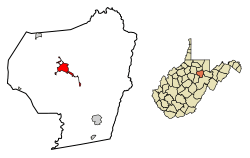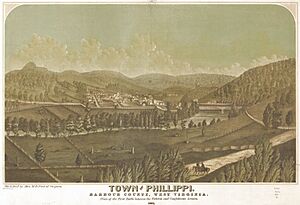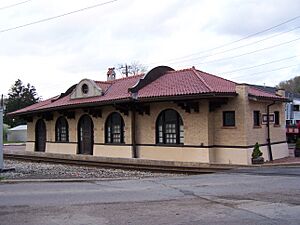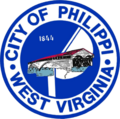Philippi, West Virginia facts for kids
Quick facts for kids
Philippi, West Virginia
|
|||
|---|---|---|---|

The Philippi Historic District with the Barbour County Courthouse seen from across the Tygart Valley River in 2007
|
|||
|
|||

Location of Philippi in Barbour County, West Virginia.
|
|||
| Country | |||
| State | |||
| County | Barbour | ||
| District | Philippi | ||
| Area | |||
| • Total | 2.92 sq mi (7.57 km2) | ||
| • Land | 2.83 sq mi (7.33 km2) | ||
| • Water | 0.09 sq mi (0.24 km2) | ||
| Elevation | 1,302 ft (397 m) | ||
| Population
(2020)
|
|||
| • Total | 2,928 | ||
| • Estimate
(2021)
|
2,922 | ||
| • Density | 1,150.88/sq mi (444.35/km2) | ||
| Time zone | UTC-5 (Eastern (EST)) | ||
| • Summer (DST) | UTC-4 (EDT) | ||
| ZIP code |
26416
|
||
| Area code(s) | 304/681 | ||
| FIPS code | 54-63292 | ||
| GNIS feature ID | 1544780 | ||
Philippi (pronounced 'FILL-uh-pea') is a city in Barbour County, West Virginia, United States. It is the main city, also known as the county seat, of Barbour County. The city is located along the Tygart Valley River. In 2020, about 2,929 people lived there.
Philippi is famous for being the site of the Battle of Philippi in 1861. This event was nicknamed the "Philippi Races." Even though it was a small fight, it is seen as the very first land battle of the American Civil War. The city also has its own weekly newspaper, called The Barbour Democrat.
Contents
A Look Back at Philippi's History
How Philippi Began
The first European settlers arrived in the area that is now Barbour County around 1780. At that time, this land was part of western Virginia. The first people to settle where Philippi now stands were William Anglin (around 1783 or 1784) and Daniel Booth (in 1787).
This spot was important because a ford, a shallow place to cross a river, was here by 1789. It was part of a road connecting Beverly and Sandy Creek. William Anglin owned the land first, so the area was known as Anglin's Ford. Daniel Booth later ran a ferry here in the 1790s, and people called it Booth's Ferry. In 1818, William Friend Wilson, who married Booth's daughter, built a mill on the river.
In 1825, the first post office in the region opened. Henson Lewis Hoff, a young man from Loudoun County, started it. He settled near Philippi. Because of him, the community was known as "Hoffsville" until 1841.
Founding and Naming the City
In March 1843, new counties were created from larger ones in western Virginia. Barbour County, which included Hoffsville, was one of them. In April 1843, the new county decided to set up its main town, or county seat, on William F. Wilson's farm. This place was still known as Booth's Ferry.
The county was named after Philip P. Barbour, a lawyer and judge from Virginia. The people wanted to honor his first name, Philip. They chose the name "Philippa," which is the feminine form of Philip in Latin. However, because of spelling mistakes and confusion with an ancient city called Philippi, the name eventually became "Philippi." The city was officially established in 1844.
In 1852, Lemuel Chenoweth, a skilled architect and carpenter, built a covered bridge in Philippi. This bridge helped connect the turnpike (a road where you pay a fee) between Beverly and Fairmont. The Philippi Covered Bridge replaced the ferry and is still a famous landmark in the town today.
Philippi During the Civil War
Philippi was the site of the very first land battle of the American Civil War, on June 3, 1861. This battle was quickly called the "Philippi Races" because the Confederate soldiers in town ran away so fast. Today, this battle is re-enacted every June during the town's 'Blue and Gray Reunion.'
On the morning of June 3, Union forces, led by Colonel Benjamin Franklin Kelley and Colonel Ebenezer Dumont, attacked. They had about 3,000 men. They surprised about 800 poorly armed Confederate soldiers led by Colonel George A. Porterfield. The Union troops had marched all night in heavy rain to arrive just before daylight.
The surprise attack came from "Battle Hill" to the northwest. It woke up the sleeping Confederates. After firing a few shots, the Southern soldiers quickly ran away to the south. Some were still in their bed clothes!
This Union victory, which had very few casualties, made young Major General George B. McClellan famous. He soon became the commander of all Union armies. The battle also led to more people in western Virginia speaking out against leaving the Union. A few days later, in Wheeling, a meeting called the Wheeling Convention declared Virginia's decision to leave the Union invalid. They named Francis H. Pierpont as governor. These events eventually led to West Virginia becoming a separate state.
Later History of Philippi
Philippi officially became a city by a law passed on February 1, 1871. The first railroad, a narrow gauge line, arrived in Philippi on January 25, 1884. Three years later, the line was extended. In 1891, it became a standard gauge line when the B&O took it over. In 1904, the city's people voted to start making electricity using gas.
In 1901, Broaddus College moved to "Battle Hill," which overlooks Philippi. In 1932, Broaddus College joined with Alderson Academy. These two Baptist schools became Alderson–Broaddus College. In 2013, the school changed its name to Alderson Broaddus University.
In 1905, a new Barbour County Courthouse was finished. It was designed in a grand Romanesque Revival style.
Train activity in Philippi was busiest in the 1920s. As many as six passenger trains, plus mail and freight trains, passed through the town every day. However, cars became more popular, and local train service declined. The last passenger train stopped in Philippi in 1956.
Throughout its history, Philippi has experienced floods because it is close to the river and much of the town is low. The most damaging flood happened in November 1985. Since then, the town has made plans to manage floods.
On July 31, 2023, Alderson Broaddus University was ordered to stop accepting new students and could no longer grant degrees. This was due to its financial problems. On the same day, the university's leaders decided to close the school.
Philippi's Location and Landscape

Philippi is located along the Tygart Valley River. Its exact location is 39°9′6″N 80°2′36″W / 39.15167°N 80.04333°W. The city is divided into four sections called Wards.
The United States Census Bureau says the city covers about 2.95 square miles (7.57 square kilometers). Most of this area, about 2.86 square miles (7.33 square kilometers), is land. The rest, about 0.09 square miles (0.24 square kilometers), is water.
The first settlement was on flat land near a bend in the river. This area is now called "Dayton Park." Across the river, there is a steep ridge known as "Nobusiness Hill." Most of the town is on the flat land. However, part of it, including the university campus, is on another ridge called "Battle Hill." To the south, "Grabanickel Hill" completes the ring of high ground around the town.
A railroad line still runs through Philippi, but only freight trains use it now. Passenger train service stopped in 1956. The old train station from 1911 is now the Barbour County Historical Museum. Philippi also has a small, private airport.
Philippi's Climate
Philippi has hot, humid summers and generally mild to cool winters. This type of weather is called a humid subtropical climate.
| Climate data for Philippi, West Virginia | |||||||||||||
|---|---|---|---|---|---|---|---|---|---|---|---|---|---|
| Month | Jan | Feb | Mar | Apr | May | Jun | Jul | Aug | Sep | Oct | Nov | Dec | Year |
| Mean maximum °F (°C) | 67 (19) |
66 (19) |
76 (24) |
84 (29) |
85 (29) |
90 (32) |
89 (32) |
91 (33) |
88 (31) |
80 (27) |
76 (24) |
69 (21) |
91 (33) |
| Mean daily maximum °F (°C) | 40.6 (4.8) |
43.2 (6.2) |
53.5 (11.9) |
66.0 (18.9) |
72.3 (22.4) |
80.6 (27.0) |
82.6 (28.1) |
82.9 (28.3) |
77.3 (25.2) |
65.8 (18.8) |
56.2 (13.4) |
44.3 (6.8) |
63.8 (17.7) |
| Daily mean °F (°C) | 30.8 (−0.7) |
32.6 (0.3) |
41.5 (5.3) |
52.9 (11.6) |
60.0 (15.6) |
69.1 (20.6) |
72.0 (22.2) |
72.0 (22.2) |
65.5 (18.6) |
53.6 (12.0) |
44.5 (6.9) |
34.4 (1.3) |
52.4 (11.3) |
| Mean daily minimum °F (°C) | 20.9 (−6.2) |
22.0 (−5.6) |
29.4 (−1.4) |
39.7 (4.3) |
47.7 (8.7) |
57.5 (14.2) |
61.5 (16.4) |
61.1 (16.2) |
53.6 (12.0) |
41.5 (5.3) |
32.8 (0.4) |
24.5 (−4.2) |
41.0 (5.0) |
| Mean minimum °F (°C) | 1 (−17) |
5 (−15) |
14 (−10) |
26 (−3) |
35 (2) |
47 (8) |
50 (10) |
52 (11) |
41 (5) |
30 (−1) |
21 (−6) |
8 (−13) |
1 (−17) |
| Average precipitation inches (mm) | 3.74 (95) |
3.39 (86) |
4.49 (114) |
3.92 (100) |
4.91 (125) |
4.94 (125) |
5.18 (132) |
3.77 (96) |
3.75 (95) |
3.26 (83) |
4.24 (108) |
3.62 (92) |
49.21 (1,251) |
| Average snowfall inches (cm) | 16.2 (41) |
10.1 (26) |
7.3 (19) |
1.1 (2.8) |
trace | 0 (0) |
0 (0) |
0 (0) |
0 (0) |
0 (0) |
1 (2.5) |
4 (10) |
39.7 (101.3) |
| Average extreme snow depth inches (cm) | 7 (18) |
5 (13) |
4 (10) |
1 (2.5) |
0 (0) |
— | — | — | — | — | — | — | 7 (18) |
| Average precipitation days (≥ 0.01 inches) | 17 | 13 | 14 | 14 | 14 | 13 | 12 | 11 | 11 | 11 | 13 | 16 | 159 |
| Average relative humidity (%) | 84 | 84 | 80 | 78 | 79 | 77 | 78 | 77 | 78 | 79 | 77 | 82 | 79 |
| Mean monthly sunshine hours | 105.4 | 115.8 | 176.7 | 240 | 272.8 | 291 | 303.8 | 313.1 | 264 | 173.6 | 156 | 124 | 2,536.2 |
| Mean daily sunshine hours | 3.4 | 4.1 | 5.7 | 8 | 8.8 | 9.7 | 9.8 | 10.1 | 8.8 | 5.6 | 5.2 | 4 | 6.9 |
| Average ultraviolet index | 2 | 2 | 3 | 4 | 5 | 5 | 6 | 5 | 4 | 3 | 2 | 2 | 4 |
| Source 1: National Weather Service(1981-2010, Temperatures 1999-2009) | |||||||||||||
| Source 2: Weather Atlas(Humidity-Sunshine-UV) | |||||||||||||
People Living in Philippi
| Historical population | |||
|---|---|---|---|
| Census | Pop. | %± | |
| 1890 | 378 | — | |
| 1900 | 665 | 75.9% | |
| 1910 | 1,038 | 56.1% | |
| 1920 | 1,543 | 48.7% | |
| 1930 | 1,767 | 14.5% | |
| 1940 | 1,955 | 10.6% | |
| 1950 | 2,531 | 29.5% | |
| 1960 | 2,228 | −12.0% | |
| 1970 | 3,002 | 34.7% | |
| 1980 | 3,194 | 6.4% | |
| 1990 | 3,132 | −1.9% | |
| 2000 | 2,870 | −8.4% | |
| 2010 | 2,966 | 3.3% | |
| 2020 | 2,929 | −1.2% | |
| 2021 (est.) | 2,922 | −1.5% | |
| U.S. Decennial Census | |||
What the 2020 Census Shows
The 2020 census counted 2,929 people and 1,311 households in Philippi. The city had about 1,037 people per square mile. Most residents, 84.6%, were White. About 8% were African American, and 0.7% were Asian. About 0.2% were Native American. Another 1% were from other races, and 5.3% were from two or more races. Hispanic or Latino people made up 3.6% of the population.
Out of 1,311 households, 30.6% were married couples living together. About 35.9% had a female head of household with no spouse. About 24.4% had a male head of household with no spouse. And 42.1% were non-family households. The average household had 2.93 people. The average age in the city was 41.8 years.
What the 2010 Census Showed
The census in 2010 counted 2,966 people, 1,185 households, and 686 families in Philippi. The population density was about 1,037 people per square mile. There were 1,383 housing units. Most people, 92.7%, were White. About 2.3% were African American, and 1.1% were Native American. About 0.9% were Asian, and 0.2% were from other races. About 2.9% were from two or more races. Hispanic or Latino people made up 0.7% of the population.
Out of 1,185 households, 26.0% had children under 18 living with them. About 38.6% were married couples living together. About 14.5% had a female head of household with no spouse. About 4.8% had a male head of household with no spouse. And 42.1% were non-family households. About 36.3% of all households were single people. About 15% had someone living alone who was 65 or older. The average household had 2.16 people, and the average family had 2.78 people.
The average age in the city was 36.4 years. About 17.8% of residents were under 18. About 20.9% were between 18 and 24. About 20.5% were from 25 to 44. About 23.8% were from 45 to 64. And 17.1% were 65 or older. About 45.3% of the city's population was male, and 54.7% was female.
Philippi's Economy and Jobs
Philippi's economy used to rely heavily on coal mining and the railroad industry. However, these industries have become much smaller since the mid-1900s. Now, the main employers in town include Broaddus Hospital. Many people in Philippi work in the service industry, in education, or on family farms.
The city government helps the local economy by providing many services and jobs. These include water, electricity, garbage collection, and waste water treatment. The city also has a professional police department and a volunteer fire department. In 2004, the City of Philippi was named an "All American City."
Interesting Places to Visit in Philippi
- The Philippi Covered Bridge (built in 1852) is located where U.S. Routes 250 and 119 meet in downtown Philippi. This bridge is famous because it was used during the first land battle of the Civil War. It is the only "twin-barreled" covered bridge on a federal highway in the United States. It is also one of the longest covered bridges in the country.
- The Barbour County Historical Museum is in the old railway station. It shows local history, mostly from the 1800s. One unusual exhibit is the "Philippi Mummies." These are preserved bodies of two women from an asylum. A local doctor, Graham Hamrick, who was interested in mummification, preserved them in 1888.
- The "Campbell Schoolhouse" is a one-room school that has been saved on the former Alderson Broaddus campus.
- Philippi is home to a Maronite hermitage called Our Lady of Solitude. This is unusual for a town of its size.
Historic Places to See
Several places in Philippi are listed on the National Register of Historic Places. This means they are important historical sites.
- Barbour County Courthouse
- Peck-Crim-Chesser House
- Philippi station
- Philippi Covered Bridge
- Philippi Historic District
- Whitescarver Hall
Famous People From Philippi
- Ann Maria Reeves Jarvis (1832–1905) was a social activist. She, along with her daughter Anna Marie Jarvis (1864–1948), helped create Mother's Day. Ann Jarvis lived in Philippi for several years.
- Alston G. Dayton (1857–1920) was a U.S. Representative for West Virginia from 1895 to 1905. He was born and practiced law in Philippi.
- Actor Ted Cassidy (1932–79) played "Lurch" and "Thing" on the 1960s TV show The Addams Family. He grew up in Philippi and graduated from Philippi High School around 1950.
- Lyle Williams (1942–2008) was a U.S. Representative from Ohio. He was born in Philippi.
- Scott Mayle (born 1983) is a former NFL player. He was born and raised in Philippi. He played football for Philip Barbour High School, Ohio University, and then in the NFL.
Images for kids
See also
 In Spanish: Philippi (Virginia Occidental) para niños
In Spanish: Philippi (Virginia Occidental) para niños









